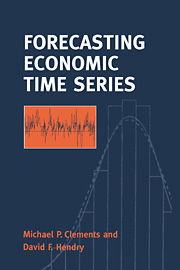Book contents
- Frontmatter
- Contents
- List of figures
- List of tables
- Preface
- Common acronyms
- 1 An introduction to forecasting
- 2 First principles
- 3 Evaluating forecast accuracy
- 4 Forecasting in univariate processes
- 5 Monte Carlo techniques
- 6 Forecasting in cointegrated systems
- 7 Forecasting with large-scale macroeconometric models
- 8 A theory of intercept corrections: beyond mechanistic forecasts
- 9 Forecasting using leading indicators
- 10 Combining forecasts
- 11 Multi-step estimation
- 12 Parsimony
- 13 Testing forecast accuracy
- 14 Postscript
- Glossary
- References
- Author index
- Subject index
2 - First principles
Published online by Cambridge University Press: 02 November 2009
- Frontmatter
- Contents
- List of figures
- List of tables
- Preface
- Common acronyms
- 1 An introduction to forecasting
- 2 First principles
- 3 Evaluating forecast accuracy
- 4 Forecasting in univariate processes
- 5 Monte Carlo techniques
- 6 Forecasting in cointegrated systems
- 7 Forecasting with large-scale macroeconometric models
- 8 A theory of intercept corrections: beyond mechanistic forecasts
- 9 Forecasting using leading indicators
- 10 Combining forecasts
- 11 Multi-step estimation
- 12 Parsimony
- 13 Testing forecast accuracy
- 14 Postscript
- Glossary
- References
- Author index
- Subject index
Summary
This chapter sets the scene for the remainder of the book. The basic concepts of unpredictability and forecastability are defined, and the notions of loss functions and optimal predictors addressed. The mechanics of generating forecasts using time series ARIMA models are described. The role of causal information in forecasting is investigated under a variety of assumptions about the relationship between the process that generated the observed data and the forecasting model of that process.
- Type
- Chapter
- Information
- Forecasting Economic Time Series , pp. 33 - 51Publisher: Cambridge University PressPrint publication year: 1998

